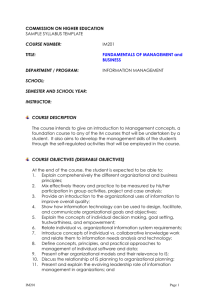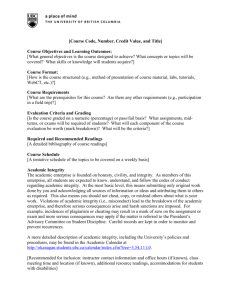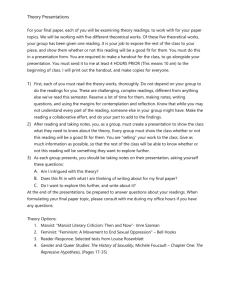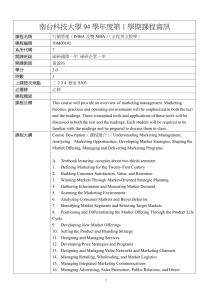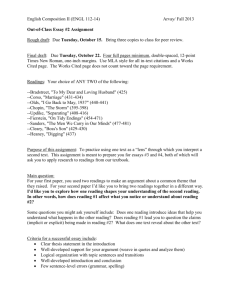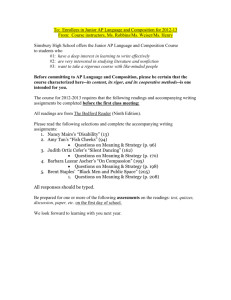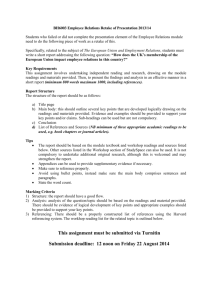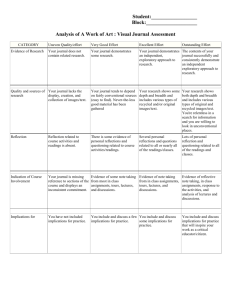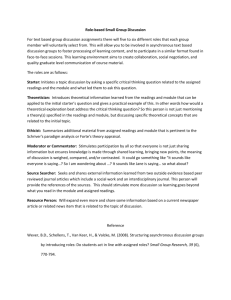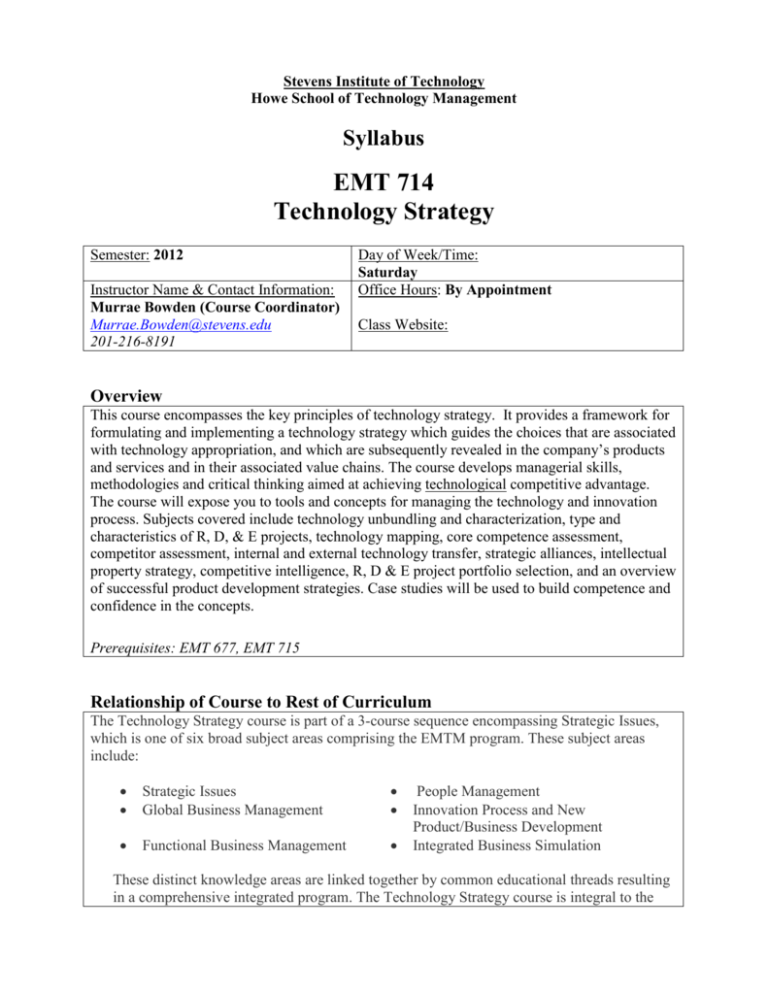
Stevens Institute of Technology
Howe School of Technology Management
Syllabus
EMT 714
Technology Strategy
Semester: 2012
Instructor Name & Contact Information:
Murrae Bowden (Course Coordinator)
Murrae.Bowden@stevens.edu
201-216-8191
Day of Week/Time:
Saturday
Office Hours: By Appointment
Class Website:
Overview
This course encompasses the key principles of technology strategy. It provides a framework for
formulating and implementing a technology strategy which guides the choices that are associated
with technology appropriation, and which are subsequently revealed in the company’s products
and services and in their associated value chains. The course develops managerial skills,
methodologies and critical thinking aimed at achieving technological competitive advantage.
The course will expose you to tools and concepts for managing the technology and innovation
process. Subjects covered include technology unbundling and characterization, type and
characteristics of R, D, & E projects, technology mapping, core competence assessment,
competitor assessment, internal and external technology transfer, strategic alliances, intellectual
property strategy, competitive intelligence, R, D & E project portfolio selection, and an overview
of successful product development strategies. Case studies will be used to build competence and
confidence in the concepts.
Prerequisites: EMT 677, EMT 715
Relationship of Course to Rest of Curriculum
The Technology Strategy course is part of a 3-course sequence encompassing Strategic Issues,
which is one of six broad subject areas comprising the EMTM program. These subject areas
include:
Strategic Issues
Global Business Management
Functional Business Management
People Management
Innovation Process and New
Product/Business Development
Integrated Business Simulation
These distinct knowledge areas are linked together by common educational threads resulting
in a comprehensive integrated program. The Technology Strategy course is integral to the
Innovation thread, which prepares managers to significantly improve their firm’s
introduction of profitable, new, high-technology products and services to the market.
Learning Goals
After successfully completing this course, the student will be able to:
1. Identify the critical elements of a firm’s technology platform from its products and services.
2. Develop a coherent technology strategy that will provide the firm with a sustainable
competitive advantage.
3. Acquire the confidence to eventually manage and lead the technology strategy and
innovation management process.
4. Communicate with business management using appropriate concepts, tools and terminology
In addition to the discipline-based knowledge, emphasis is placed on developing skills in oral
and written communication, teaming and critical thinking.
Pedagogy
Formal lectures will deal with concepts, principles, theories and techniques to impart knowledge
and increase understanding of the various topics. The lectures will be augmented by case
assignments selected to emphasize the topics covered in the lectures and make the knowledge
relevant to the students’ experience enabling them to utilize the course material to develop and
complete elements of the final project. The last case (Term Project) integrates the work of all the
preceding lectures. Three of the case assignments are done in teams in order to improve strategic
thinking and team skills. Two individual case assignments are also given.
Required Text(s)
Technology Strategy for Managers and Entrepreneurs by Scott Shane, Pearson/Prentice Hall, 2009
Required Readings
Executive Forum: Price, R. M., “Technology & Strategic Advantage”, California Management
Review, 38 (3), 38 (1996).
Porter, M.E., “How Competitive Forces Shape Strategy.” Harvard Business Review, March - April 1979,
pg. 137 - 145. (Porter Model).
Suarez, F. and Lanzolla, G., The Half-Truth of First Mover Advantage, Harvard Business Review,
April 2005, p121.
Wheelwright, S.C. and Sasser, W.E., “The New Product Development Map.”
Harvard Business Review, May-June, 1989, pg. 112-120
2
Koen, P. A., “Technology Maps: Choosing the Right Path,” Engineering Management Journal, 9 (4) pg. 7
- 11, 1997.
Iansiti, M., “Real-World R & D: Jumping the Product Generation Gap.”
Harvard Business Review, May-June, 1993, pg. 138-147.
Albright, R. E. and Kappel, T. A., Research Technology Management, 46 (2), 31 2003.
Kanter, R. M., “Collaborative Advantage: The Art of Alliances.” Harvard Business Review, pg. 96-108,
July-August, 1994
Kerstetter, J. and Burrows, P., A CEO’s Last Stand, Business Week, July 26, 2004
Christensen, C. M., “Making Strategy: Learning by Doing,” Harvard Business Review, pg. 1-12, Nov. –
Dec. 1997
Nayak, P. R. and Ketteringham, J. M., “3M Notepads”, Breakthroughs, Pfeiffer, pg. 35-56, 1994.
Cooper, R. G., Edgett, S. J. and Kleinschmidt, E. J., “Portfolio Management in New Product
Development: Lessons from the Leaders – I.” Research Technology Management, September - October
1997, pg. 16 - 28.
Cooper, R. G., Edgett, S. J. and Kleinschmidt, E. J., “Portfolio Management in New Product
Development: Lessons from the Leaders – II.” Research Technology Management, November December 1997, pg. 43 - 52.
Additional Readings
Optional Reading
Kahaner, L., Competitive Intelligence. Touchstone, New York, NY, 1996
Lynch, R.P., Business Alliance Guide – The Hidden Competitive Weapon. Wiley, NY, 1993
Rivette, K., Kline, D., Rembrandts in the Attic. HBS, Boston 2000.
Assignments
The course will emphasize class discussion and analysis of readings and cases.
CASE ASSIGNMENTS
The assignments for the course consist of both individual case assignments and team-based case
assignments that examine specific components of strategy discussed in class.
FINAL TEAM PROJECT
The final team based case assignment represents 35% of the grade and involves development of a
comprehensive Five-Year Technology Strategy for a technology-based company/SBU chosen by each
team at the beginning of the course. The team’s assignment is to recommend a strategy to gain a
sustainable competitive advantage in the firm’s industry.
This final case project is a chance for you to pull together the different elements of the course into one
document. This assignment will integrate much of what you have already completed in previous weeks.
The strategy should be clear, concise, flow logically, and hopefully introduce some new ideas and
3
thinking that will improve the competitiveness of your company or SBU.
.
Desired Structure
I INTRODUCTION
BUILDING
BLOCKS
II .CORPORATE
STRATEGY
III. R, D &E
FRAMEWORK
IV. CORE
COMPETENCIES,
COMPETITOR
ASSESSMENT
V. TECHNOLOGY
ACQUISITION
VI. TECHNOLOGY
PROTECTION
VII. PROJECT/PORTFOLIO
SELECTION
“PUTTING IT ALL
TOGETHER"
FINAL REPORT
CLASS PARTICIPATION
Class participation is an important component of this class. Your questions, comments, insights, and
overall contribution in class will be evaluated, and a maximum of 10 points will be given towards your
final grade.
The assignments and their weights are as shown below:
Assignment
Case I: Corp Strategy (Team)
Case II: Apple Inc. (Individual)
Case III: CC & Tech. Roadmapping (Team)
Grade
Percent
15%
15%
15%
4
Case IV: 3M (Individual)
Final Team Project
Class Participation
Total Grade
10%
35%
10%
100%
Ethical Conduct
The following statement is printed in the Stevens Graduate Catalog and applies to all
students taking Stevens courses, on and off campus.
“Cheating during in-class tests or take-home examinations or homework is, of course,
illegal and immoral. A Graduate Academic Evaluation Board exists to investigate
academic improprieties, conduct hearings, and determine any necessary actions. The
term ‘academic impropriety’ is meant to include, but is not limited to, cheating on
homework, during in-class or take home examinations and plagiarism.“
Consequences of academic impropriety are severe, ranging from receiving an “F” in a
course, to a warning from the Dean of the Graduate School, which becomes a part of the
permanent student record, to expulsion.
Reference:
The Graduate Student Handbook, Academic Year 2003-2004 Stevens
Institute of Technology, page 10.
Consistent with the above statements, all homework exercises, tests and exams that are
designated as individual assignments MUST contain the following signed statement
before they can be accepted for grading.
____________________________________________________________________
I pledge on my honor that I have not given or received any unauthorized assistance on
this assignment/examination. I further pledge that I have not copied any material from a
book, article, the Internet or any other source except where I have expressly cited the
source.
Signature ________________
Date: _____________
Please note that assignments in this class may be submitted to www.turnitin.com, a webbased anti-plagiarism system, for an evaluation of their originality.
5
Course Schedule
FALL 2011 SATURDAY PROGRAM (8 sessions)
Saturday
Hoboken
Lecture
#
9/10
Afternoon
1
Outline & Deliverables
Readings
Module 0 – Course Overview
Chapters 1 & 4, Ch 15, p344-346 of
‘Technology Strategy for Managers and
Entrepreneurs’ (Shane)
Executive Forum
Technology & Strategic Advantage
Module 1 - Introduction
Readings [Module 1]
Selected articles from popular press
Polaroid Case Assignment
9/24
AM/PM
2
Module II Corporate Strategy
Polaroid Case Discussion (in Class)
Case I – Corporate Strategy (TEAM)
Assignment Requirements
Chapter 11 of ‘‘Technology Strategy for
Managers and Entrepreneurs’ (Shane)
Case: Polaroid: Entering Digital Imaging
Readings [Module 2]
1. How Competitive Forces Shape Strategy
2. Timely Transformation
Chapter 10 of ‘Technology Strategy for
Managers and Entrepreneurs’ (Shane)
Readings [Module 2]
3. The Half Truth of First Mover Advantage
4. 2005 Annual Report – Linear Tech
10/8
AM/PM
3
Module IIIa – R, D&E Framework
*Case I - Corporate Strategy Due
Case II – Technology, Standards &
Competitive Strategy (Apple)
Assignment Requirements (Individual)
10/22
AM/PM
4
Module IIIb – RD&E Framework
Cont.
*Case II – Apple Inc. Due
Chapters 2 ,12 of ‘Technology Strategy for
Managers and Entrepreneurs’ (Shane)
Case: Apple Inc. 2010
Readings [Module 3]
1. The Changing Agenda for Research
Management (Mitchell)
2. The New Product Development Map
(Wheelwright& Sasser)
3. Technology Maps (Koen)
4. Roadmapping in the Corporation (Albright
& Kappel)
In-class review of Case I
Review Case III Assignment
6
Virtual
10/24-10/31
5
Module IV – Core Competencies &
Competitor Assessment
Review Case III
Technology Roadmapping
Chapter 11 of ‘Technology Strategy for
Managers and Entrepreneurs’ (Shane)
Readings [Module 4]
1. The Core Competence of the Corporation
(Prahalad & Hammel)
Assignment Requirements
11/5
AM/PM
6
Module V – Technology Acquisition Chapter 14 of ‘Technology Strategy for
Managers and Entrepreneurs’ (Shane)
In-Class review of Case II (Apple
Inc)
*Case IIIA Strategic Roadmapping
Framework (Team) Due
Readings [Module 5]
1. Glass Menagerie, (Fahey)
2. Collaborative Advantage: The Art of
Alliances (Moss-Kantor)
3. Outsourcing for Innovation (Cheesbrough
& Teece)
Alliance Video shown
11/12
11/19
AM/PM
CAPSTONE
7
Module VI – Technology Protection Chapters 8 and 9 of ‘Technology Strategy for
Managers and Entrepreneurs’ (Shane)
-Case IV - 3M Assignment
Requirements (Individual)
* Case IIIB - Core Competencies &
Strategic Roadmapping (Team) Due
12/3
AM/PM
8
Module VI I – Project Portfolio
Selection
*Case IV - 3M Breakthrough
Technologies (Individual) Due
12/17
AM/PM
9
Case Assignment: 3M’s Post-It Notepads,
(Nayak, & Ketteringham)
Readings [Module 6]
1. A Market for Ideas: Patents and
Technology Survey
2. Getting the Most From Your Patents
(Berkowitz)
3. Putting Competitive Intelligence to Work
(Nordling et al.)
Chapter 5 of ‘Technology Strategy for
Managers and Entrepreneurs’ (Shane)
Readings [Module 7]
1. Portfolio Management in New Product
Development: Lessons from the Leaders I
and II (Cooper, Edgett & Kleinschmidt
2. Countering Risk (Slywotsky & Drzik)
Putting it all Together
Team Presentations
7
EMT 714 CLASS SCHEDULE
FALL 2011 WEEKDAY PROGRAM (13 sessions)
Thursday
(Clifton)
Lecture
#
9/15
Afternoon
1
EMT.714
TECHNOLOGY STRATEGY
Module 0 – Course Overview
Readings
Chapters 1 & 4, Ch 15, p344-346 of
‘Technology Strategy for Managers and
Entrepreneurs’ (Shane)
Executive Forum
Technology & Strategic Advantage
Module 1 - Introduction
Readings [Module 1]
Articles – Bus. Week, WSJ, etc.
Polaroid Case Assignment
9/22
Afternoon
2
Module 1 Conclusion
Module II Corporate Strategy
Polaroid Case Discussion (in Class)
Case I – Corporate Strategy (TEAM)
Assignment Requirements
9/29
Afternoon
3
Module II Corporate Strategy
(Cont)
Chapter 11 of ‘‘Technology Strategy for
Managers and Entrepreneurs’ (Shane)
Case: Polaroid: Entering Digital Imaging
Readings [Module 2]
How Competitive Forces Shape Strategy
Cures for an Industry in Crisis
Articles – Bus Wk. WSJ, etc.
Chapter 10 of ‘Technology Strategy for
Managers and Entrepreneurs’ (Shane)
Readings [Module 2]
The Half Truth of First Mover Advantage
2005 Annual Report – Linear Tech
10/06
Afternoon
4
Module III – R, D. & E Framework Chapters 2 ,12 of ‘Technology Strategy for
Managers and Entrepreneurs’ (Shane)
*Case I - Corporate Strategy Due
Case II – Technology, Standards &
Competitive Strategy (Apple)
Assignment Requirements (Individual)
Case: Apple Inc. 2010
Readings [Module 3]
5. The Changing Agenda for Research
Management (Mitchell)
6. Articles
8
10/13
Afternoon
5
Module III – RD&E Framework
Cont.
10/20
Afternoon
6
Module III – RD&E Framework
Cont.
*Case 2 – Apple Inc. Due
(Individual)
7. Technology Maps (Koen)
8. Roadmapping in the Corporation (Albright
& Kappel)
9. Fundamentals of Technology Roadmapping
(Sandia)
Case III- Technology Roadmapping
Assignment Requirements
10/27
Afternoon
7
Module IV – Core Competencies &
Competitor Assessment
In Class Review of Apple Case
Assignment
Chapter 11 of ‘Technology Strategy for
Managers and Entrepreneurs’ (Shane)
Readings [Module 4]
The Core Competence of the Corporation
(Prahalad & Hammel)
Case III Assignment Reprise
11/03
Afternoon
8
Module V – Technology
Acquisition
*Case IIIA Strategic Roadmapping
Framework (Team) Due
Chapter 8 of ‘Strategic Management of
Technology & Innovation’ (Schilling)
Readings [Module 5]
Glass Menagerie, (Fahey)
Collaborative Advantage: The Art of
Alliances (Moss-Kantor)
Alliance Video shown
9
11/10
Afternoon
9
Module V Technology Acquisition
Cont.
Module VI – Technology
Protection
*Case IIIB - Technology Roadmapping
(Team) Due
-Case IV - 3M Assignment
Requirements (Individual)
11/17
Afternoon
10
11/24
12/1
Afternoon
Module VI – Technology
Protection Cont.
Chapters 8 and 9 of ‘Technology Strategy for
Managers and Entrepreneurs’ (Shane)
Case Assignment: 3M’s Post-It Notepads,
(Nayak, & Ketteringham)
Readings [Module 6]
A Market for Ideas: Patents and Technology
Survey
Getting the Most From Your Patents
(Berkowitz)
Readings [Module 6]
What is an Intellectual Property Strategy
(Meade)
NO CLASS THIS WEEK
THANKSGIVING RECESS
11
*Case IV - 3M Breakthrough
Technologies (Individual) Due
Putting Competitive Intelligence to Work
(Nordling et al.)
Module VI – Technology
Protection
Module VI I – Project Portfolio
Selection
12/8
Afternoon
12
Module VI I – Project Portfolio
Selection Cont.
Chapter 5 of ‘Technology Strategy for
Managers and Entrepreneurs’ (Shane)
Readings [Module 7]
3. Portfolio Management in New Product
Development: Lessons from the Leaders I
and II (Cooper, Edgett & Kleinschmidt
4. Countering Risk (Slywotsky & Drzik)
12/15
Double Session
13
*714 Final Team Project Due
Group Presentations
10

